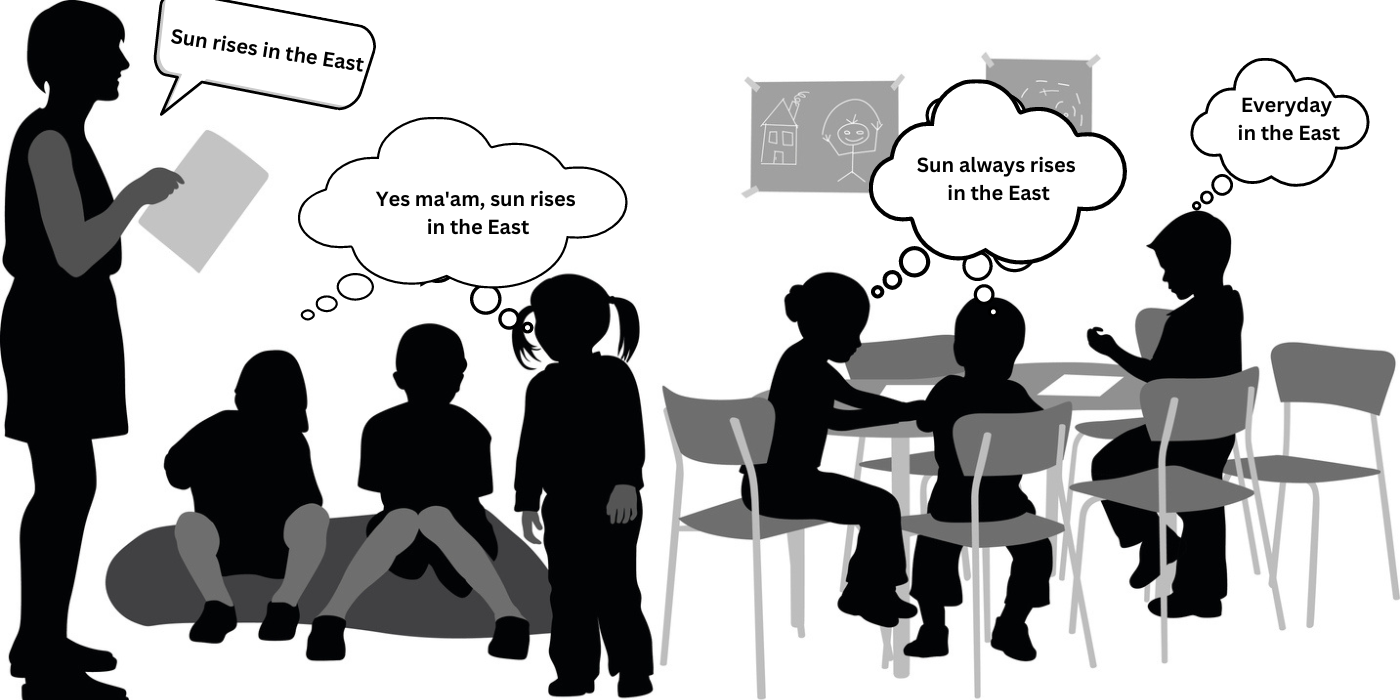Banking concept of education refers to the conventional methods of narrative teaching wherein the teachers relay and fill up the students with the course content and the students simply memorize the narrated content mechanically and store it in themselves.
The term – banking concept of education was first coined by Paulo Freire in his book Pedagogy of the Oppressed – which is an attempt to aid the oppressed sects in fighting back and regaining their lost humanity.
While Freire has outlined the steps following which the oppressed could achieve humanization, he has also critically analyzed traditional education as a means of serving the interest of the oppressors since it inhibits students from developing critical thinking.
Table of Contents
Paulo Freire’s Banking concept of education – A summary
As per Freire, a critical analysis of the teacher-student relationship at all levels both outside and within the institution reveals that the traditional method of teaching is fundamentally narrative in character – which he terms as the banking concept of education.
In the banking model, the teacher is considered as the subject (depositor) while the students are considered as “patient, listening objects” (depositories). The teacher narrates the content (be it of real experience or observation) in a way that becomes lifeless and petrifying to the students, devoid of motion, completely static, and predictable.
His task is to ‘fill up’ the students with the contents of his teaching, even if they are detached from reality or are words that have been hollowed out.
“Four times four is sixteen; the capital of Para is Belem.”
Cited from Pedagogy of the Oppressed by Paulo Freire
As the teacher keeps on narrating, the students imbibe the phrases, memorize them and keep on repeating, even without actually perceiving what capital means to a country, or what four times four actually means.
While the students keep on memorizing the narrated content mechanically, they soon turn into containers that are being filled by the teacher. This form of education thus simply becomes an act of depositing, where the teacher is the depositor, and the students, the depositories – thus arising the term “Banking concept of education”.
Why is the banking concept of education bad?
Paulo sees this banking concept of education as a means of serving the interests of the oppressors in further oppressing the weaker sects. Not only does this banking model of education limit the students to only “receiving, storing and filling the deposits” but also strikes off creativity and critical thinking abilities in them.
One of the main drawbacks of this banking concept of education is that knowledge here is portrayed to be a gift. This gift is conferred by a few who consider themselves to be knowledgeable to those whom they consider being ignorant or lacking in knowledge.
A similar story appears in the traditional student-teacher setting, wherein the teacher occupies the role of being knowledgeable and considers the students to know nothing. This projection of absolute ignorance onto others is what Paulo describes as an ideology of oppression.
Further, the banking concept of education in its characteristics also mirrors certain parts and practices of the oppressive society, as he lists below:
(a) the teacher teaches and the students are taught;
(b) the teacher knows everything and the students know nothing;
(c) the teacher thinks and the students are thought about;
(d) the teacher talks and the students listen—meekly;
(e) the teacher disciplines and the students are disciplined;
(f) the teacher chooses and enforces his choice, and the students comply;
(g) the teacher acts and the students have the illusion of acting through the action of the teacher;
(h) the teacher chooses the program content, and the students (who were not consulted) adapt to it;
(i) the teacher confuses the authority of knowledge with his or her own professional authority, which she and he sets in opposition to the freedom of the students;
(j) the teacher is the Subject of the learning process, while the pupils are mere objects.
Cited from Pedagogy of the Oppressed by Paulo Freire
As the students are more and more engrossed in safeguarding the deposits entrusted by the teacher, the lesser they develop critical thinking skills. This in turn leads to involuntary acceptance of the passivity imposed upon these students, resulting in them accepting the world as it is.
This particular capability of the banking concept of education which nullifies the student’s creativity acts in favor of the oppressors, who want the world not to be transformed but to forever submitted to their dominance.
The banking model in adult education
Paulo has also analyzed the presence and consequences of this banking concept of education in adult education. While this model never proposes the students to reflect upon and explore critical thinking, it imposes upon them thoughts that are mostly devoid of humanism, thus turning them into automatons.
It will deal instead with such vital questions as whether Roger gave green grass to the goat, and insist upon the importance of learning that, on the contrary, Roger gave green grass to the rabbit.
Cited from Pedagogy of the Oppressed by Paulo Freire
As a consequence of this model, there might be a point when students revolt against this imposing of beliefs, which Paulo describes as “domestication”. Through their experience of real life, they would soon realize that reality is a process of constant transformation, far from what they have been taught as static and predictable.
Paulo’s alternative to the banking concept of education
While Paulo justifies his stand against the traditional banking concept of education and how it knowingly or unknowingly aids the interests of the oppressors, he offers an alternative – Problem-posing education.
Whereas banking education anesthetizes and inhibits creative power, problem-posing education involves a constant unveiling of reality.
Cited from Pedagogy of the Oppressed by Paulo Freire
Problem-posing education strives to create a sense of consciousness and encourages critical thinking. In this method, the students are constantly presented with real-life challenges and soon are obliged to respond to those. By virtue of these challenges being real-life and not theoretical in nature, the students learn to explore their interests and strengths and gradually develop self-confidence and commitment.

Banking concept of education vs Problem-posing education
Here’s a look at the generalized difference between banking education and problem-posing education as put forward by Paulo Freire:
1) The banking concept of education ‘mythicizes’ certain facts, i.e. it conceals selected facts and explanations that explain the existence of human beings.
Problem-posing education, on the contrary, exposes such critical facts.
2) Banking model of education ‘resists dialogue’, i.e. prevents interactive questioning and imposes a specific content.
Its counterpart, on the flip side, regards dialogue and questioning as integral part that develops cognition in the students.
3) While the banking concept of education inhibits creativity in the students and makes them mere depositories, the problem-solving model stimulates creativity and authenticity, thus affirming their self-confidence.
Read Pedagogy of the Oppressed online.
You may also ask
1) What is the banking concept of education?
The Banking concept of education refers to the conventional methods of narrative teaching wherein the teachers relay and fill up the students with the course content and the students simply memorize the narrated content mechanically and store it in themselves.
2) What is banking and problem-posing concept of education?
Banking concept of education – It refers to the conventional methods of narrative teaching wherein the teachers (depositors) relay and fill up the students with the course content and the students (depositories) simply memorize the narrated content mechanically and store it in themselves.
Problem-posing concept of education – Problem-posing education strives to create a sense of consciousness and encourages critical thinking by constantly presenting students with real-life challenges, who are and soon are obliged to respond to those.
By virtue of these challenges being real-life and not theoretical in nature, the students learn to explore their interests and strengths and gradually develop self-confidence and commitment.
3) Give me a banking concept of education example.
As per Paulo Freire, the traditional teacher-student relationship is that of the banking concept of education. The teachers simply narrate the course content to the students who in turn memorize the content mechanically.
In this case, the teacher assumes the role of a depositor who fills up the students with the curated content and the students become the depositories, who memorize, store, and repeat the content mechanically. The whole setup can be compared to a bank, thus the term banking concept of education.
4) When was the banking concept of education published?
The Banking concept of education was first published in Paulo Freire’s Pedagogy of the Oppressed (written in Portuguese) in 1968 in Spain. It was later translated into English and published in 1970. The original version was published in Portugal in 1972 and in 1974, in Brazil.
Also read: The concept of education
About the author
Paulo Freire (Paulo Reglus Neves Freire) was born on September 19, 1921 in Pernambuco, Brazil. Revered as one of the twentieth century’s most influential philosophers, his motto was to eradicate illiteracy and uplift the living conditions of the oppressed class. The book Pedagogy of the Oppressed is considered to be one of his most notable works.
Read more about Freire, from the Internet Encyclopedia of Philosophy.










Leave a Reply